
If you scroll through Mark Clennon’s IG account, you can see his evolution as a photographer.
He started out taking pictures of landscapes—cobblestone streets in SoHo, the Hollywood sign in Los Angeles, the Apollo Theater at night in Harlem—then he ventured into shooting subjects, creative-looking Black men and women who seem completely at ease on the other side of his lens. You can see the evolution of his discerning eye as his shoots become more dynamic and his subjects’ gazes get more intense.
All of this helped prepare him for the reckoning that took place this summer after the murders of George Floyd and Breonna Taylor at the hands of police officers. He wasn’t completely new to shooting protests, but honing in on his skills over the last few years set him up to capture this moment from a very particular perspective. Clennon is responsible for one of the most memorable shots from the New York City protests: a picture of a Black man standing in front of Trump Tower wearing a durag with his fist raised in the air.
“That photo probably changed my life. It probably changed my career,” says Clennon. “But I can’t help but think about how this has happened because a Black man was killed by the police. And that picture happened because there's a systemic issue in America with our police and the government that supports them.”
But how did he go from Florida transplant to full-time New York City photographer? We spoke to Clennon about his come-up, what he’s trying to achieve with his images, and how he was able to leave his 9-to-5 and photograph full time.

What did you study in college?
I went to USF in Tampa, Florida. I switched my major five times because I didn't know what I wanted to do. So, I started out pre-med, and pretty soon realized I'm not built for that. And then I bounced around to other majors. Eventually I switched my major to advertising and PR. I wanted to do something like media, so I just majored in that. But it was in those classes where I learned about design. I thought I wanted to be a graphic designer. So, all through college, I was throwing parties and making fliers for the parties. That's kind of my introduction to some of the tools that I use now for photography.
What was the plan after you graduated?
I had no plans. I graduated and I was one of those kids that was kicking it. I was still doing the club promotion stuff. So, that was enough money to keep me afloat. Then I got a job doing graphic design and I went into tech. I was in tech sales and marketing. It was boring. I'd go to a desk and we had to push ads. I knew I wanted to do something else, but I didn't know exactly what. After a year in Florida a friend was like, "Yo, I need a roommate. I'm moving to New York." And I had some money saved up so I just moved to New York and that was the first time I had ever been to New York. I had lived in Florida my whole life. I just wanted to move to a bigger city.
What did you do once you got to New York?
I had no job and I just hustled and finally got a job at a tech company because that's what I was doing before. I worked there for years, and I was okay at it, but I just never really fit in. I didn't like wearing suits. I didn't like wearing Patagonia vests. So, I started the [now defunct] website URBNfresh.com. It was kind of similar to Complex. I would go on Complex.com, and I would go on Tumblr and take the photos and put them on my website. And then the photographers would hit me up like, "Hey, you can't just take my photo like that. That's wrong.” I'm like, oh, okay. I'm like, alright, well, whatever. I'll just take my own photos with my phone.
And I just went around New York taking pictures on my iPhone, just to get them on the website. And that's when the photography kind of stuck and I just went harder with the iPhone photography. And then for Christmas my mom bought me a Canon T5i. I walked around New York taking pictures. It was harder than I thought. Then I put my camera down and I didn't pick it up for a whole other year because it was just too hard. I guess, in a way, I was scared of looking like a beginner. It wasn't until the following year, around 2016, that I picked it up again seriously, and the second time I really tried, it really stuck.

When did you decide to quit your full-time job and pursue photography full time?
February 2016 is when I really started going hard, and I did my first single shoot of a person that year. I was working full time, but it was great because I could say no to certain things. It wasn't feeding me or anything, like now. I was shooting club parties just to earn money to buy a better lens or something like that. So, that's what kept me afloat. My New Year's resolution in 2017 was to quit my job. But January 2017 came and I was like, “Nah, I'm definitely not ready.” I didn't have any client lists. I was just shooting. So, I got wind that there were going to be layoffs at my job in June. June came and I didn’t get laid off. I waited three more months to get my quarterly bonus and then I official quit my job in October 2017. I went full time into photography without any consistent clients, but people at least knew that I was a photographer. And I just kind of went from there.
What do you like to shoot?
When I first started shooting, it was all buildings. I'm from Florida. It's flat there. We don't have buildings like that. I was inspired by people like black_soap on IG and Visuals by Pierre and trying to do the cityscape thing. But I started to grow more as an artist. I found I got more joy out of taking pictures of people. And so, really, the springboard for me taking pictures of people was Afropunk, because everybody's already dressed up at Afropunk. All I have to do is come up with the camera and take pictures of them. So Afropunk was the real kicking off moment for me. I got my first placement in Huffington Post from shooting Afropunk. So in 2016 and 2017 is when I went full speed on portraiture and fashion. But for me, I hate committing to one specific style of edit or one specific genre. Like, I'm just interested in telling the whole story. So, that's why I do have documentary work, I do have fashion stuff, I do have structural-type landscape stuff in my portfolio, because I like it all.

Was it difficult to find clients?
I just found a new way to network. I hate “networking.” But what I did early on was reach out to new stylists and models and say, “Hey. Let’s all do something together and figure it out.” So now I have like these little pods of people and they grew, and were able to recommend me for jobs. So, without even realizing, I was networking.
At first I thought I needed a mentor or somebody to help put me on. But then I realized if I just put my head down and went as hard as I can, and control what I can control, all the mentorship would attract itself to me, because they saw that I was already in motion. So, I was just focused on staying in motion and just keeping active. And that was the best way to advertise myself, was just to keep going.
You describe your work as whimsical defiance. How are you separating your work from that of your peers?
When I first started shooting. I literally only had access to my network, right? So at first, everybody I started shooting was Black. I don’t think I did it intentionally. That's just what it was. And then, as I met new people, they were saying you need to diversify the people you photograph. And I was like, “Okay. I spent all that time at a job doing stuff I didn't want to do.” And so when people told me I needed to do things differently in my work, I wasn’t going to do it because I already know how that feels. So I just stuck to it.
I like capturing movement. I feel like Black people just move in a cool way. We walk in a cool way. So, I like to capture those in between moments where there's a little bit of motion. And I'm a fidgety person. I'm really walking around my house. I like to walk around while I'm talking on the phone. So I like to climb on things and shoot below. I like to get down and shoot above. I like those types of movements. I like those weird, weird close-ups. It's like one eye. Those weird close-ups interest me and are what kind of differentiates my work. But another thing that’s really key is the variety. I refuse to commit to one single thing, because I personally get tired of my own work really quickly. So, I'll go ahead and switch up the way I color things. The minute I feel like I’m getting boxed in to a certain shooting style, I’ll shoot a different way.

Do you feel boxed in? Do clients expect something specific from you?
Not really. Sometimes, someone will reach out to me, and they're like, "We want something in your style," and I'm like, “Okay, which style?” But when I talk to clients and get them on the phone and we chat it out, we all have a common thread. But I'll look at Gordon Parks' career. He did it all. He did documentary style, he shot on movie sets, and he did fashion work. And it's funny because when I talk to people, especially older Black people, they know Gordon Parks as the Black documentarian. They're not familiar with his fashion editorial stuff. And I think that's because for his fashion and editorial stuff, he had to shoot mainly white people because that was what was available to him. So there's a whole older class of Black folks that aren't as familiar with his other work because there was a lack of visibility for Black models and Black stylists. So, that's kind of how I'm approaching my path, moving forward. Not comparing myself to him, to his greatness, but seeing him as a blueprint for what could be possible.
Let’s talk about the photo a little. How did it happen? How do you feel about people’s reaction to it?
That photo probably changed my life. It probably changed my career. It put a giant spotlight on the work that I've been doing, which is great. But I can’t help but think about how this has happened because a Black man was killed by the police. And that picture happened because there's a systemic issue in America with our police and the government that supports them. They're killing us, right? That is the crux of why I stepped out that day and that is the crux of why people were interested in the photo in the first place. The man raised his fist, and because he wanted to fight injustice, made his voice be heard because of George Floyd, Breonna Taylor, and everybody who has been harmed, killed, shot by the police since the inception of America, right? So I always have to say that first, because I don't want to distract from the core fighting their way in. It's an ongoing thing, right? And I'm happy that I had the opportunity to add to this discourse. I had the opportunity to give an image that kind of speaks for so many, and I feel good about how it's been received and I feel good about what it means to a lot of people.
I've kind of separated myself from it. It's kind of just living its own life. And I'm really just most looking forward to seeing how it ages—I want to see how it is perceived in 10 years, because I feel like, as an artist, all you ever want to do is make something that lives longer than you and have a legacy that is bigger than your body. And I feel like [the photo] has done that, so I just feel, honestly, like I’m watching a plant grow. I just want to see how the meaning of it will change. Like, what will this election do to the definition of the image? Will they knock the tower down one day? At first literally hundreds of people in my DMs were asking to buy, people made T-shirts. There was a protest in Germany. They printed the photo on the back of a hoodie, that was mind-blowing to me. I would love for it to be in the Smithsonian. I would love for it to be in textbooks.

What’s next?
What's next for me is just to continue to tell the story of Black lives in every way. And that's what I think I'm doing. Right? With the documentary stuff, I'm telling the story of Black lives and protest, or just living life on a regular day. With my editorial stuff, I'm showing Black people in a fantasy world and realizing and actualizing our dreams and creativity, right? Creating the scene and the spaces for us to be imaginative. And then, with the commercial work, I'm putting power back in the Black creator's hand.
I mean, obviously, commercial and editorial can overlap, and that's kind of like the money spot, but for me, I welcome everything. I feel like whatever you want to call this moment in my career, I don't think it came too early. I feel like me working a full career up until this point prepared me for this, you know what I'm saying? Prepared for me to take advantage of this attention and really just lock in as an entrepreneur and as a creator. I want to continue to tell our story in an authentic way, and just making sure that my voice is speaking to my audience and create cultural moments and have fun. I'm a photographer, photography is fun. You know what I'm saying?

